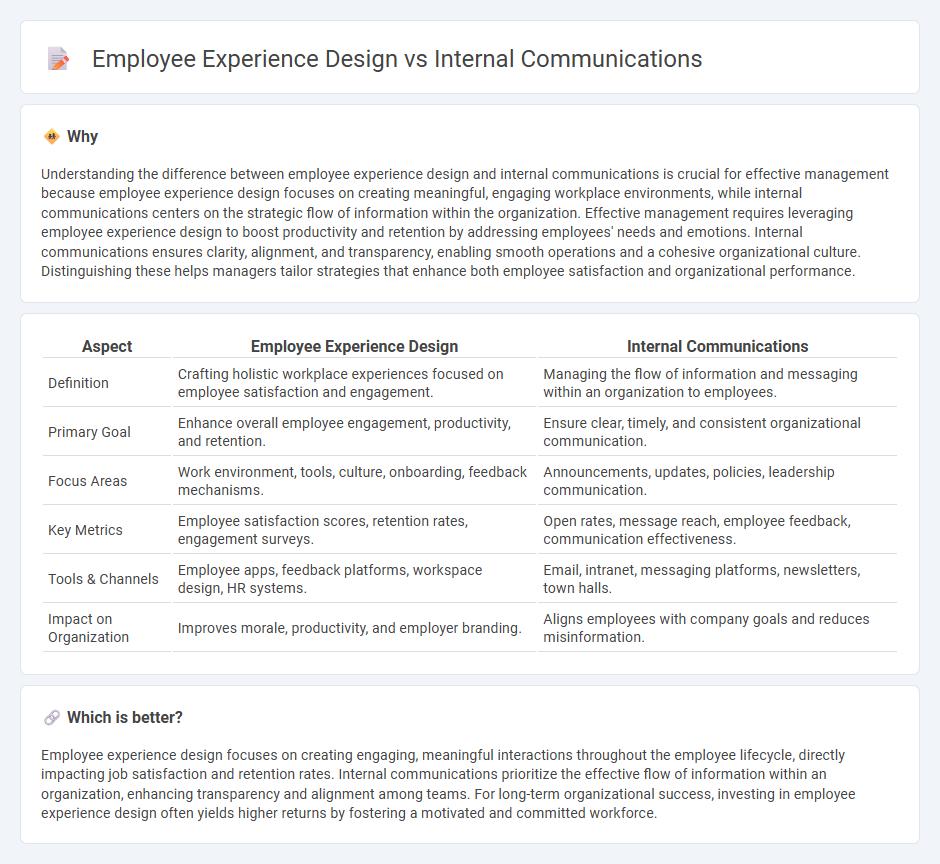
Employee experience design focuses on creating seamless, engaging interactions throughout the employee lifecycle to boost satisfaction and productivity. Internal communications prioritize the effective dissemination of information and fostering transparent dialogue within the organization. Explore how integrating both strategies enhances overall workplace culture and performance.
Why it is important
Understanding the difference between employee experience design and internal communications is crucial for effective management because employee experience design focuses on creating meaningful, engaging workplace environments, while internal communications centers on the strategic flow of information within the organization. Effective management requires leveraging employee experience design to boost productivity and retention by addressing employees' needs and emotions. Internal communications ensures clarity, alignment, and transparency, enabling smooth operations and a cohesive organizational culture. Distinguishing these helps managers tailor strategies that enhance both employee satisfaction and organizational performance.
Comparison Table
| Aspect | Employee Experience Design | Internal Communications |
|---|---|---|
| Definition | Crafting holistic workplace experiences focused on employee satisfaction and engagement. | Managing the flow of information and messaging within an organization to employees. |
| Primary Goal | Enhance overall employee engagement, productivity, and retention. | Ensure clear, timely, and consistent organizational communication. |
| Focus Areas | Work environment, tools, culture, onboarding, feedback mechanisms. | Announcements, updates, policies, leadership communication. |
| Key Metrics | Employee satisfaction scores, retention rates, engagement surveys. | Open rates, message reach, employee feedback, communication effectiveness. |
| Tools & Channels | Employee apps, feedback platforms, workspace design, HR systems. | Email, intranet, messaging platforms, newsletters, town halls. |
| Impact on Organization | Improves morale, productivity, and employer branding. | Aligns employees with company goals and reduces misinformation. |
Which is better?
Employee experience design focuses on creating engaging, meaningful interactions throughout the employee lifecycle, directly impacting job satisfaction and retention rates. Internal communications prioritize the effective flow of information within an organization, enhancing transparency and alignment among teams. For long-term organizational success, investing in employee experience design often yields higher returns by fostering a motivated and committed workforce.
Connection
Employee experience design directly influences internal communications by shaping how messages are tailored to meet workforce needs and preferences. Effective internal communications enhance employee engagement, promote transparency, and reinforce organizational culture, which are critical components of a positive employee experience. Integrating these elements leads to improved collaboration, higher productivity, and stronger retention rates.
Key Terms
Information Flow
Internal communications primarily focus on optimizing the flow of information within an organization to ensure clarity, timeliness, and consistency across all channels. Employee experience design integrates internal communications with workplace culture, tools, and feedback mechanisms to create a holistic environment that enhances employee engagement and productivity. Explore how aligning information flow with experiential design drives meaningful organizational transformation.
Organizational Culture
Internal communications shape organizational culture by ensuring clear, consistent messaging that aligns with company values, fostering employee engagement and trust. Employee experience design enhances culture by creating meaningful workplace interactions and environments that promote well-being and productivity. Discover how integrating both strategies can transform your organizational culture effectively.
Feedback Mechanisms
Effective internal communications prioritize clear, timely feedback mechanisms that enable employees to voice concerns and contribute ideas, fostering a collaborative culture. Employee experience design integrates these feedback loops into holistic systems, enhancing engagement and satisfaction by continuously adapting workplace environments and processes. Discover more about optimizing feedback strategies to transform internal communications and elevate employee experience design.
Source and External Links
Internal Communications In 2025: What You Need To Know - Firstup - Internal communications is a continuous process that keeps employees informed and connected through verbal, written, and digital channels, using data-driven and personalized messaging aligned with business goals to boost engagement and productivity.
What is Internal Communications? Definition & Best Practices | Simpplr - Internal communications involves sharing information to support employees' work, with best practices including reaching all employees, having a clear strategy, two-way feedback channels, consistent messaging, avoiding overload, ensuring equality, and measuring engagement.
17 Internal Communication Examples from Companies Big & Small - Internal communication covers strategic communication, onboarding, policy updates, engagement efforts, change management, and more to align employees with company goals and create a positive work culture.
 dowidth.com
dowidth.com